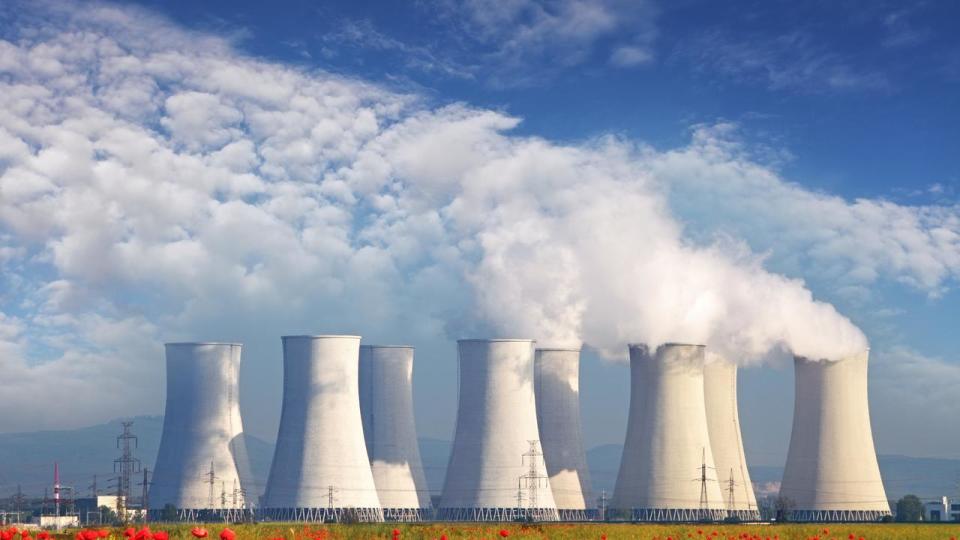‘Multiple reactors’: New detail in nuke plan

Opposition energy spokesman Ted O’Brien has flagged an evolution in the Coalition’s nuclear power policy, revealing that each of the seven sites could host multiple reactors.
But in a major concession, Mr O’Brien said on Sunday the Coalition would go to the election without detailing the estimated generation capacity of the seven Commonwealth-owned nuclear power plants it plans to connect to the grid across five states between 2035 and 2050.
“One of the lessons we learned from overseas, in order to get prices down, you need multi-unit sites,” Mr O’Brien told the ABC’s Insiders program.
“Let’s say the small modular reactors … When you talk about a nuclear plant, these are modularised compartments. You can add another 300, add another 300.
“You’re talking about multi-unit plants.”

While hosting more than one reactor at each site would increase the share of generation from nuclear power, it would significantly drive up the cost incurred by taxpayers and place further pressure on the already tight deadline to have the reactors online by mid-century.
Asked about how many gigawatts of output could be expected from the Coalition’s nuclear proposal, Mr O’Brien said the decision would be ultimately made after an independent nuclear energy co-ordinating authority made recommendations on the number and type of reactors per site.
“The independent body would look at each plant, and come up with a recommendation as to what sort of technology should be used,” he said.
“From there, it would be exactly what capacity based on that technology.
“Only from there can you come down to a specific number of gigawatts”.
Estimates from the Grattan Institute have placed the combined output of seven reactors at up to 10GW, or less than 4 per cent of the total generation capacity in the national energy market (NEM) by 2050 of 300GW.
With energy policy set to be a key battleground in the next election, Mr O’Brien said the Coalition would instead release the share of the total energy generation in the NEM “in due course”, rather than a specific amount.
“Until we release renewables policy and gas policy, I won’t be talking about the proportion of the mix,” he said.
“We’ll be clear as to what we believe the potential capacity could be through to 2050.”
Mr O’Brien also declined to reveal what proportion of generation in the grid would be made up by renewables, a move that is unlikely to ease concerns raised by business and investors over the uncertainty posed by the Coalition’s energy plan.
“I’m a Liberal and I appreciate and respect that investors want to make money, but to be really clear our focus is on the Australian people that want to save money,” he said.
Despite the relatively small generation capacity expected from nuclear energy, Nationals Leader David Littleproud, who has previously said renewable investment should be capped under the nuclear power plan, continued to indicate the nuclear plan would be in lieu of renewable generation.
“The maths is pretty simple, you’re not going to have as much large-scale renewable energy into the system,” Mr Littleproud told Sky News, while arguing there would be fewer transmission lines.
But Mr O’Brien confirmed there was “no discussion about capping investment”,
“We need investment continuing on renewables,” he said.

While the Coalition’s nuclear plans remain uncosted thus far, Mr Littleproud revealed the estimated construction costs were “in the ballpark” of the $8.6bn price tag per reactor that was previously forecast by the CSIRO.
Analysis released by the Smart Energy Council shows the cost incurred to taxpayers of the Coalition’s pledge to build seven nuclear reactors would be at least $116bn, and could push as high as $600bn. That figure does not factor in the aggressive renewable rollout that would still be required under the Coalition’s plan.
Meanwhile, costings released by the energy market operator placed the total expenditure required to fund all generation, storage, firming and transmission infrastructure under Labor’s plan at $121bn.
The Nationals Leader also indicated that government would have some involvement in setting electricity prices, noting that the ownership of the nuclear facilities would help “drive down the cost” of consumers’ power bills.
“That’s where if the government has control over it, then we have greater capacity to reach in,” Mr Littleproud said.
Mr O’Brien also revealed the Coalition’s energy policy would include “market reforms” but did not provide further detail.
Plibersek takes aim at lack of cost, detail
Also speaking on Sunday, Labor frontbencher Tanya Plibersek added her voice to the tirade of criticism against the Opposition’s nuclear energy push, criticising the Coalition for its refusal to detail the estimated cost to add nuclear generation to the national electricity market in the biggest overhaul of energy policy in decades.
“He’s saying to Australians: ‘I don’t trust you. I don’t trust you with the costing we’ve done,’ if he’s got costings,” Ms Plibersek told Sky News.
“On every analysis internationally, renewables are cheaper, nuclear is the most extensive.

“What is it going to do to pay for his power bills if the government is recouping the very expensive cost of building and running those nuclear reactors?”
Asked why Australia had eschewed nuclear power when many other advanced economies had adopted the technology, Ms Plibersek pointed to Australia’s comparative advantage in renewable power generation.
“We’ve got the room, we’ve got the resources, we’ve got the critical minerals we need, battery manufacturing, we’re investing in green hydrogen,” Ms Plibersek said.
“We can be a renewable energy superpower and instead Peter Dutton wants to slam the brakes on, instead of leading the world with renewable energy investment.
“He wants to fast track nuclear, and put us on the slow lane when it comes to renewables. It’s just mad.”
Meanwhile, a new Resolve Political Monitor poll conducted for the Age and Sydney Morning Herald, shows 41 per cent favour nuclear power while 37 per cent are against with 22 per cent undecided.]


